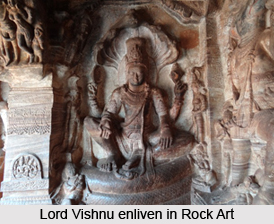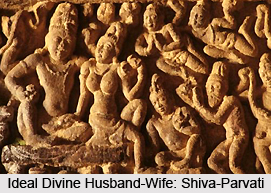 Badami Chalukya sculptures closely resembled the Dravidian architecture. This kind of sculpture evolved in the 5th century and continued till the 8th century. Two kinds of monuments developed under the Badami Chalukyas: rock-cut temples and structural temples. The features of Badami Chalukya sculpture include intricate stone works and outstanding figurines. Soapstone was widely used as the building material. Columned halls, pillared verandahs and `garbhagrihas` are the main architectural elements of the Badami Chalukyas. Narasobba, Revadi Ovajja and Anivaritachari were some of the most reputed sculptors during the age of the Badami Chalukyas. Structural temples and rock-cut halls are two of the celebrated types of architectural wonders prevalent during that point of time. The Badami Chalukya style of sculpture is a brilliant fusion of the Dravidian or southern Indian styles and Indo-Aryan Nagara styles of architecture. The style is said to have evolved during the 5th and the 8th centuries.
Badami Chalukya sculptures closely resembled the Dravidian architecture. This kind of sculpture evolved in the 5th century and continued till the 8th century. Two kinds of monuments developed under the Badami Chalukyas: rock-cut temples and structural temples. The features of Badami Chalukya sculpture include intricate stone works and outstanding figurines. Soapstone was widely used as the building material. Columned halls, pillared verandahs and `garbhagrihas` are the main architectural elements of the Badami Chalukyas. Narasobba, Revadi Ovajja and Anivaritachari were some of the most reputed sculptors during the age of the Badami Chalukyas. Structural temples and rock-cut halls are two of the celebrated types of architectural wonders prevalent during that point of time. The Badami Chalukya style of sculpture is a brilliant fusion of the Dravidian or southern Indian styles and Indo-Aryan Nagara styles of architecture. The style is said to have evolved during the 5th and the 8th centuries.
There are numerous temples that bear testimony to the splendour of the sculptures belonging to the reign of the Badami Chalukya Dynasty, particularly the renowned Badami Cave Temples which are equipped with a sanctum carved into a rock, columned hall and a pillared verandah space.
 The most impressive feature of such temples is the presence of running frieze of `Ganas`, which portray interesting postures of deities embedded alongside the relief plinths. Experimentation in the field of idol sculpting has been attempted in the rock-cut halls, which include Jain, Vedic and Buddhist forms of architecture. Though the external verandahs of the Badami Cave Temples are devoid of sculptures, its inner halls are richly embellished with exquisite sculptural symbolism.
The most impressive feature of such temples is the presence of running frieze of `Ganas`, which portray interesting postures of deities embedded alongside the relief plinths. Experimentation in the field of idol sculpting has been attempted in the rock-cut halls, which include Jain, Vedic and Buddhist forms of architecture. Though the external verandahs of the Badami Cave Temples are devoid of sculptures, its inner halls are richly embellished with exquisite sculptural symbolism.
The temples of Pattadakal, six of which boast of Dravidian architecture are also attractive instances of Badami Chalukya sculptures. Four other Pattadakal temples have been built in the Rekhanagara style. Virupaksha Temple`s architecture resembles that of the Kailasantha Temple in Kanchipuram and its sculptures are quite unique. Pilasters have been employed to divide the outer wall surface which are adorned with perforated windows or even elaborate sculptures. The sculpture of the Shiva-Parvati posture is one of the most outstanding sculptural specimens of the Badami Chalukya era. Much later, these sculptures were introduced in the pillars which were erected during the rule of the kings of Vijayanagara Empire. The caves belonging to this particular time period possess finely carved out sculptures of `Gomateshvara`, `Harihara`, `Mahisa Mardhini`, `Tandavamurthi`, `Nataraja`, `Paravasudeva`, `Varaha`, `Trivikrama` and several others. Motifs of foliages and those of animals have also been embedded in such sculptures.
Sculptures of Badami Chalukyas are quite famous and include those observed inside the premises of Sangameswarar Temple and numerable others located in Aihole, Badami, Pattadakal, Gerusoppa and Alampur in the state of Andhra Pradesh. Mahakuteshwara Temple, Papanatha Temple, Galganatha Temple, Kashivisvanatha Temple, Mallikarjuna Temple which are all in Pattadakal, Lad Khan Temple and Durga Temple in Aihole, Bhutanatha Group of Temples and the four Cave Temples in Badami, Alampur Navabrahma Temples and Vardhamanaswamy Temple at Gerusoppa are amongst the innumerable temples which are decorated with different artistic forms of sculptures and architectural marvels.



